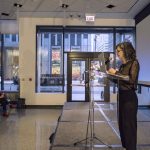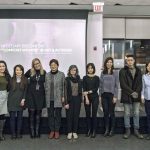My impulse in reporting on the symposium “Necessary Discomfort: ‘Comfort Women’ In Art & Activism,” which took place at the beginning of March, is to try to summarize the vast amount of information I am now in possession of. I would like to disseminate for you the history of these girls or women as a group, of East Asia during and after World War II (WWII), and of each individual’s story. I would like to dip into the oft-quoted theories of Takeuchi Yoshimi and explain to you the concept of han — which looks much like injustice, repressed rage, pain, and the need for revenge all at once.
Towards the end of the Symposium — which was two days of not only scholarship but emotion — SueEllen Semekeski, a professor of Art Therapy at SAIC thanked those in attendance, “It’s hard to get people to come to something about discomfort because we have it now in spades.” It’s true, violence against women continues to be common across the world; the relevance of these wartime atrocities was ever-present throughout the talks.
For those unfamiliar with the term, “comfort women” is a euphemism used to describe the women and girls used as sex slaves by the Japanese Imperial Army during WWII (the use of this phrasing is often challenged through the symposium). Most of these girls and women were forced into sexual service from their home nations of Korea, China, and the Philippines, among many other nations. The number of “comfort women” is still being debated, but ranges from 20,000 to 410,000. There are survivors still, and beginning with Kim Hak-Sun in 1991, they’ve begun to tell their horrifying stories — often after a lifetime of silence.
The symposium began with Dr. Elizabeth W. Son’s presentation on the use of theater to tell these women’s stories. She discussed two plays: “The Comfort Women” takes a look at women in pain from the trauma they’ve experienced, and holds families and societies responsible for hearing their stories. The translated “Nabi” takes a more personal approach. The author of “Nabi” asks is the act of testifying another violence against survivors? Can plays help alleviate that burden?
The second play, “The Trojan Women: An Asian Story,” begins with Helen telling the women of Troy to accept their fate as their city is conquered. Through stylized marionette movements it uses the lens of the “comfort women” and the Trojan War to expose the cyclical brutality of war-time violence against women.
The next two speakers, Jennifer Dorothy Lee and Sandra Shim, discussed the problematic role of women as national symbols and the Statue of Peace respectively. Shim shared many details about the Statue which is often placed outside of Japanese embassies in order to pressure the Japanese government into offering a formal and sincere apology.
The final act of the first night was a poetry reading by Emily Jungmin Yoon, author of “Ordinary Misfortunes” and the upcoming book “A Cruelty Special to Our Species.” Some of the most moving moments of the symposium came from her readings of her long poem “Testimonies” — a series of shorter sections each named after a “comfort woman” and based on their true stories.
It is while listening to these poems that I am drawn again to the backdrop chosen for the evening. A single small pair of women’s shoes surrounded by men’s boots. It nauseates me as I listen to the women’s stories, how they were kidnapped, raped repeatedly, and if they did not die, forced to live in shame.
Day two began with Dr. Kyeong-Hee Choi, who discussed an artist and survivor who expressed her experiences through her art, and the writer Park Wan-Suh. She began by questioning the relationship between the public’s understanding of comfort “women’s” — really just girls’ — maternal bodies. If they did not die, the “comfort women” were usually infertile. Many women had their stomachs slashed in violent abortions; for this and other reasons, including venereal disease and physical trauma, they were forever robbed not only of their innocence but of future motherhood.
Dr. Kyeong-Hee Choi was followed by Arianna Hess, an MA student at The School of the Art Institute of Chicago (SAIC), who presented on the artwork of Tomiyama Taeoko a Japanese artist filled with guilt over the knowledge that the “comfort women” existed. She explored this idea of guilt — guilt being its own kind of trauma. What do we do with it?
I first learned about “comfort women” studying literature in Tokyo. The topic was discussed in hushed tones like a myth, and while I was shocked, I was also in disbelief. Something so horrific couldn’t possibly be true. Not so recent. Surely I would have heard.
In her presentation, Hess alludes to her own history of trauma. Sitting in the audience, I was grateful someone had said it. The presenters and organizers were all careful to frame the information given in the symposium as potentially triggering, but even after the warning, I was shaken by the experiences and information we were asked to digest. My own past sat in the empty chair next to me, inching closer every hour.
At the beginning of each day we were asked, why are we talking about this now? The answer is that what happened then is happening today. #Metoo hangs in the air as we listen to the difficulties survivors had, and still have, coming forward. The cycle of violence against women during times of war is visited and re-visited. The complicity of Korean society as well as the Japanese military is discussed. The responsibility we all have, to remember these atrocities, is explicit.
I will forever be grateful for the organizers of this event. The Korean Graduate Student Community, the Korean Student Association, the Chinese Student and Scholar Association, the Asian and Asian American Students at SAIC, and Maverick created something powerful about an issue that so often goes unseen.
The symposium ended with a walking meditation led by Suellen Semekeski. All attendees filed one after another to walk slowly with the memory of the “comfort women’s” pain.
While we were walking, the Statue of Peace in Chicago sat still inside a box. It is unable to find a home where it will be visible due to political disagreement. This symposium was a time for pain to be seen and heard in a way it is so often ignored — or boxed away. I hope the information discussed invokes conversation and change, and I hope this change is given the long life many enslaved girls and women were not.














